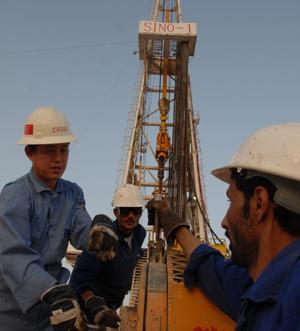China's overseas construction and engineering sector enjoyed 37 percent growth in 2009 and is expected to expand another 10 percent this year, according to China International Contractors Association yesterday.
 A Chinese employee and his Saudi Arabian colleagues work on an oil drilling project in Saudi Arabia. Chinese overseas contractors are expecting to report double-digit growth this year. [China Daily]
A Chinese employee and his Saudi Arabian colleagues work on an oil drilling project in Saudi Arabia. Chinese overseas contractors are expecting to report double-digit growth this year. [China Daily]Emerging markets such as Latin America, Vietnam and Sri Lanka are expected to become driving forces for 2010 growth, while Africa and Asian nations like India will remain major markets, said Zhang Xiang, a spokeswoman for the association.
"Emerging marketplaces have a strong basic need for infrastructure construction and they have been affected less by the financial crisis," said Zhang.
Meanwhile, growing overseas investments by Chinese companies will play a proactive role in encouraging similar firms to venture abroad, Zhang said.
"The Chinese government will continue its easing of financing policies to facilitate the process for companies to go overseas, so the sector will report steady growth in the coming years," she added.
Chinese contractors have cost advantages compared with their counterparts in developed countries, and they maintain technical advantages over competitors from developing nations, analysts said.
China's overseas projects rose for the 10th consecutive year in 2009.
Turnover in the sector reached $77.7 billion last year, an increase of 37.3 percent from a year earlier.
State-owned companies took the lead in foreign projects, as China Railway Group Ltd, Sinopec Engineering Inc and China State Construction Engineering Corp ranked as the top three overseas contractors last year.
Iran and Venezuela were the two largest overseas markets for Chinese contractors in 2009, with the value of deals hitting $11.4 billion and $9.6 billion respectively. The top three markets in 2008 were India, Libyan and Angola.
Transportation replaced home construction as the largest sector for overseas projects with a market share of 23.6 percent last year. The housing and power industries followed with market shares of 19.7 percent and 18.4 percent respectively.
Chinese companies still face challenges going overseas, such as adapting their business practices to the customs and laws of host countries, and developing effective means to integrate local staff into their operations, said Benedict Tai, a consultant at law firm Jones Day.





